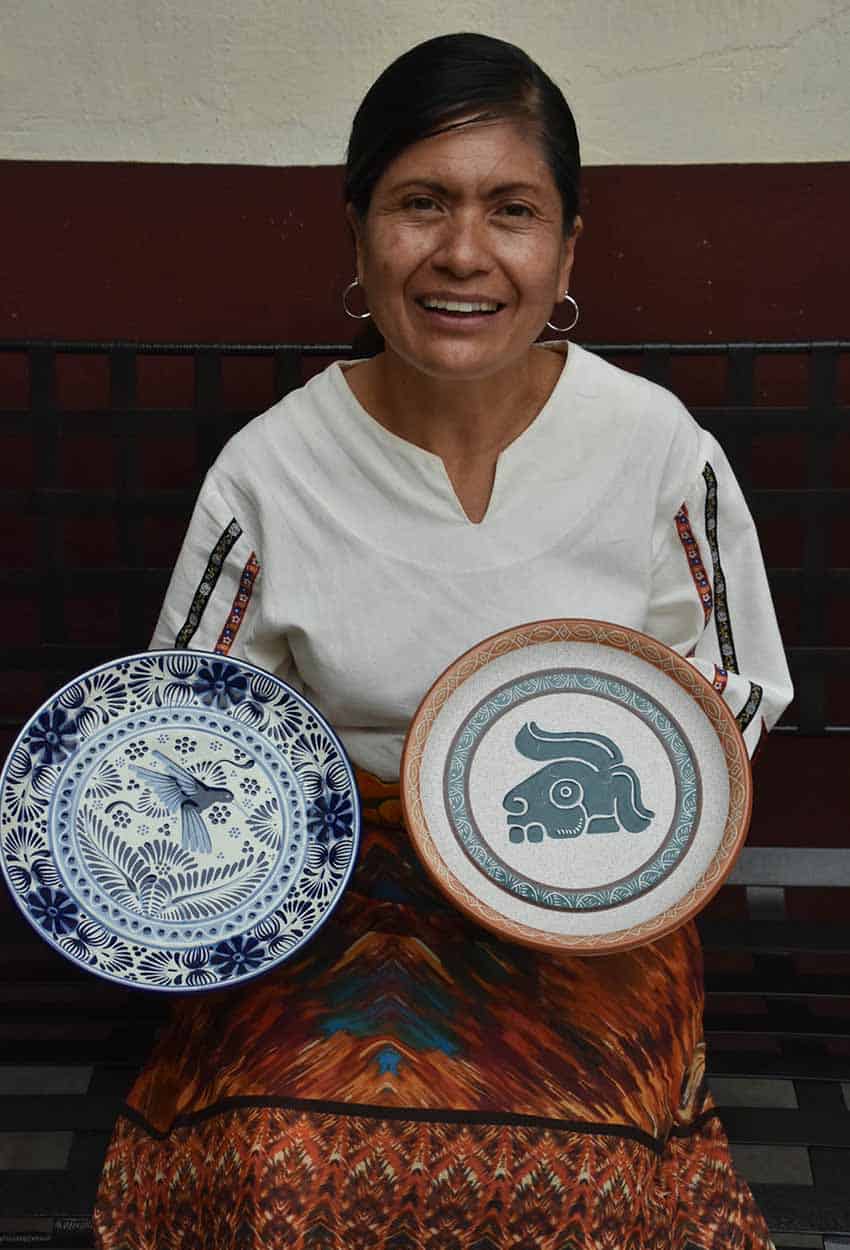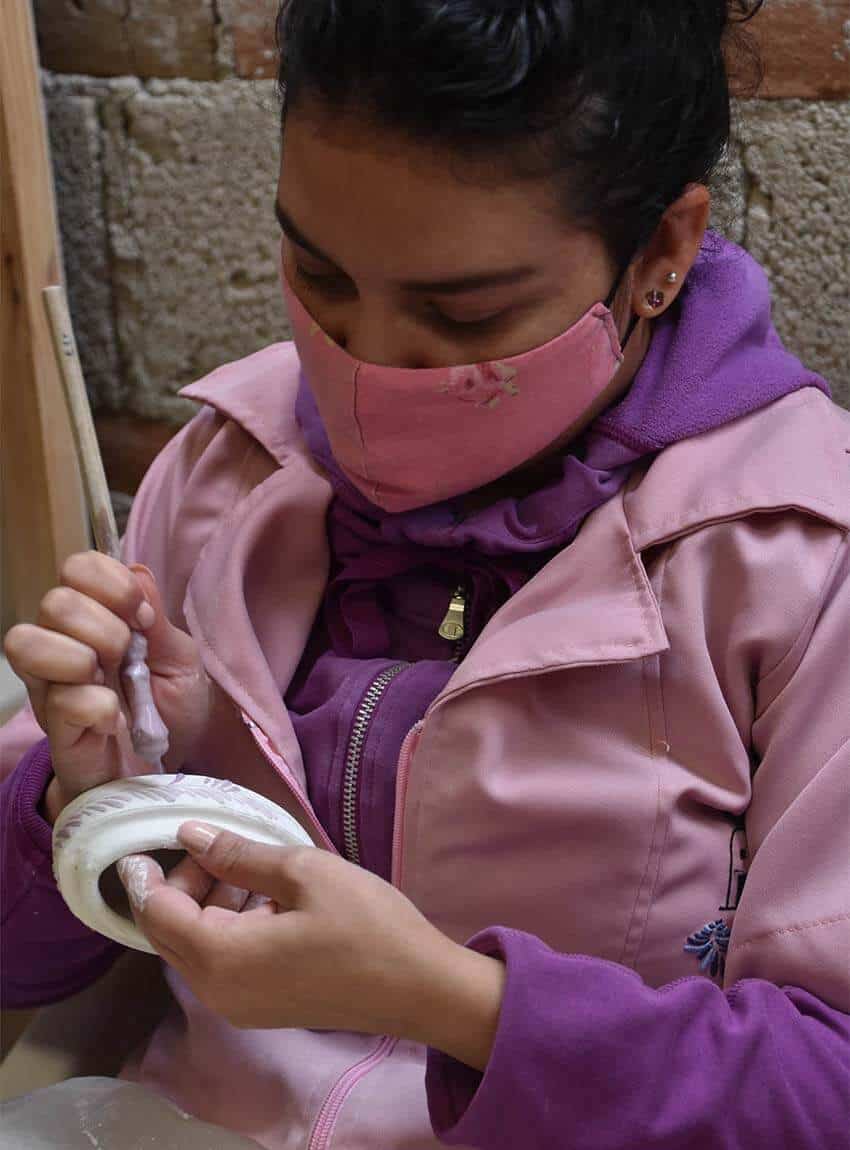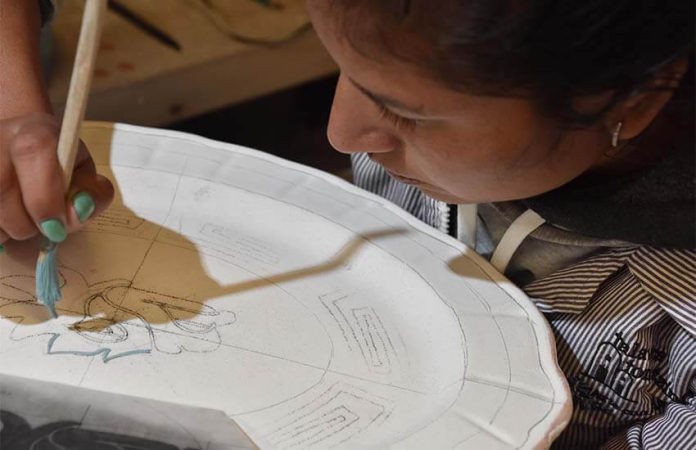Talavera pottery arrived in Mexico from Spain soon after the conquest and quickly took root in pueblos in the states of Tlaxcala and Puebla, where ceramics had already been made for hundreds of years.
Traditional Talavera has distinctive, boldly colored decorations that bear a range of patterns from the simple to the extremely complex. They may also include flowers or animals.
So, after half a millennium and an infinite number of possible designs associated with the distinctive pottery style, it would seem difficult at this point to create something new.
But Claudia Montiel León, the owner of Tonantzin workshop just outside of San Pedro Cholula, Puebla, has done exactly that by incorporating something ancient: pre-Hispanic designs and symbols.
The word Talavera comes from Talavera de la Reina, a city in Spain that became famous for its ceramics in the 15th and 16th centuries, eventually becoming known as “The City of Ceramics.” Craftsmen from that city were brought to Mexico to decorate the Church of Santo Domingo in Puebla city, whose construction began in 1571. Once there, they taught locals how to make Talavera using a potter’s wheel and tin-glazing, something that was new to them.
Clays found in the region, surrounding the active volcano Popocatépetl, are of high quality and are used in Montiel’s ceramics.
“We use a combination of clays from Ajalpan, which is in the zone near the volcano,” she said. “It is a special clay, known for its plasticity and color. It is only found in this zone.”

Once brought to her workshop, the clay is mixed with water and then placed in the sun to dry, a step that can reduce the clay’s volume by as much as 50%.
“The items must then be shaped, dried and fired the first time,” Montiel explained. “The firing is at 1030 degrees Celsius (1886 F). It takes nine hours to reach that temperature. The fire is then shut off, and the items are left to cool for nine hours. After that, the pieces are dipped in enamel and painted.”
When the paint is dry, the pieces are fired again. “Talavera is fired twice,” said Montiel. “Things like the ceramics sold in stores or stands, they are only fired once.”
Montiel’s interest in making Talavera pottery was the natural outgrowth of her work as a chemical engineer. “I worked in a lab making floor tiles and learned how to make Talavera through that work,” she said. “When my youngest child entered school, I started making [it]. I had more time to work on this.”
She started Tonantzin (which is Náhuatl for “our venerated mother”) 20 years ago and offers two kinds of ceramics: classic Talavera and ceramics with pre-Hispanic designs. She uses the same process for both. “The designs are pre-Hispanic. but the techniques are contemporary.”
She started making ceramics with pre-Hispanic designs 12 years ago. “We want to express our pre-Hispanic roots, our Cholulatecan roots, our legacy,” she said. “It is important to recognize our roots, and our roots are in ceramics. Cholula was a center for ceramics. It was the most important city in all of Mesoamerica. It was a ceremonial, religious, political, cultural, artistic and ceramics center.”
Her pre-Hispanic designs are taken — with permission — from the book, Arte y Diseño en Cerámica Prehispánica de Cholula by Carlos Pinto (Art and Design in Pre-Hispanic Ceramics of Cholula).
“In the beginning, I was interested in collecting pieces of pre-Hispanic ceramics that are found all over Cholula,” said Pinto, who studied graphic arts and design at the University of the Americas in Puebla (UDLAP). The pieces that have designs on them, he mentioned, are called tepalcates.
“My work in the book was to draw each of the designs,” he said. “These designs are all from Cholula. The designs changed a lot over the years. The first were very simple and then, in the post-Classic period, became more complex. In the post-Classic, there were artists who worked in ceramics as well as on codices.”
The post-Classic (A.D. 900–1519) is his favorite period. “The designs are more expressive,” he said. “There’s more movement in them. The designs changed from being merely ornamental to being symbolic.”
Some of the designs were influenced by ceramics brought to Cholula by other cultures. “Cholula was, and is, a sacred city dedicated to the god Quetzalcóatl, Pinto said. “All of Mesoamerica came here to venerate the god, to exchange goods, so there is much influence from other cultures. There have been some Mayan pieces uncovered here.”
In the Tonantzin workshop, Esmeralda Ramírez Gordiano sat at a table in a small cubicle, intensely focused on the piece in front of her that she was painting with a pre-Hispanic butterfly. Butterflies were important symbols in pre-Hispanic cultures.

In Cholula, butterflies were associated with warriors, fire, death and rebirth. The one she was painting was highly detailed. “It takes about four hours to paint this,” Ramírez said.
Learning to paint a piece, said Montiel, takes a significant amount of time. “It is not easy to learn,” she said. “For some women, it comes naturally. It takes six months to one year to learn to paint because it is very precise [work].”
Before she starts to paint, Ramírez uses a stencil to trace a design onto the piece. The stencil is coated with charcoal, and as she rubs the stencil with a small stone, the design is transferred to the item on which she’s working.
To complete something like the butterfly takes about one month, she said.
In addition to pieces with pre-Hispanic designs, Montiel also sells ceramic plates decorated with the days of the Mexica sacred calendar, known as the tonalpohualli, or the “count of days.” There are 20 days in that calendar, and each one has a name and symbol. Montiel’s plates have one symbol in the center and a design around the edge.
Across from Ramírez, Elizabeth Trinidad Espinoza was working on more traditional Talavera. “Some of the pieces are for clients and have a more contemporary design,” Trinidad said.
Before firing, the paint isn’t the deep-blue color typically associated with the artisan style.
“The color changes at high temperatures,” said Montiel. “It is a chemical process.” Although blue is the color most associated with Talavera, yellow, black, green, mauve and orange may also be used.
Making Talavera and pre-Hispanic ceramics is a time-consuming process. “It is difficult,” said Montiel, “because it is artisanal, made piece by piece.”
There are seven women working full-time at Tonantzin. Montiel was asked why there were only women working there. “For this work, women have more sensitivity than men,” she said. “Also, it is to help their families. They need the work.”
- You can find Tonantzin’s products in La Antigua México, a store located on Avenida Morelos 216 in San Pedro Cholula, on their Facebook or Instagram pages or by emailing them.
Joseph Sorrentino, a writer, photographer and author of the book San Gregorio Atlapulco: Cosmvisiones and of Stinky Island Tales: Some Stories from an Italian-American Childhood, is a regular contributor to Mexico News Daily. More examples of his photographs and links to other articles may be found at www.sorrentinophotography.com He currently lives in Chipilo, Puebla.
